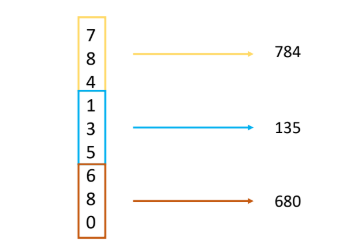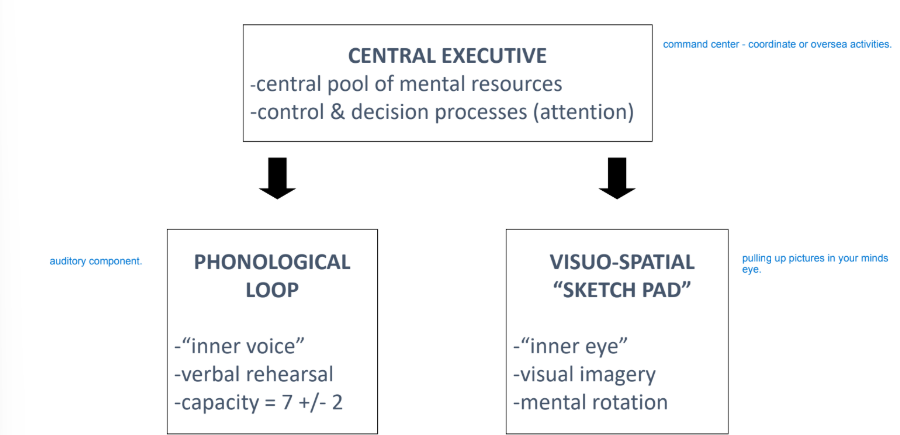Week 8 - Sensory and Short-term memory/working memory
1/41
There's no tags or description
Looks like no tags are added yet.
Name | Mastery | Learn | Test | Matching | Spaced |
|---|
No study sessions yet.
42 Terms
What is memory
The process where we use information from the past to generate/support cognitive functions in the present
active function
3 basic mechanisms of memory
Encoding
Storage
Retrieval
Encoding
The translation of information into a neural code that can be understood/represented in the brain
early on in the process
ex. moving into a new house - sorting specifics into a box
needs to turn information and create a neural code that your brain can interpret. One of the first steps to have a functional memory
Storage
Retention of the encoded information
varied length in time (depends on how much information)
need to retain the information that was stored, not a fixed length of time
ex. the box is in storage for varying times depending when you move
Retrieval
Recovering/finding the encoded, stored information for use in behavior/cognition
ex. taking the stuff out of the box out of storage
Modal Model of Memory
3 components
Sensory memory
short-term memory
Long-term memory
MMM: Information processing approach
Brain actively manipulates information and process it (need to be able to manipulate)
Humans are not passive receivers of information
some information gets transferred to long term

Sensory Memory Capacity
“sensory echo” or “sensory face”
Capacity = High, not all of it goes into short term memory
attention is a filter - it filters out irrelevant information. Similar process from sensory to short-term memory. Only some of the sensory memory will be transferred
Sensory Memory Duration
Very brief (order of milliseconds)
Example of Sensory Memory
Persistence of Vision
Phenomenon - if you light a sparkler a trace it through the air it seems to form full shapes, this echo happens because your sensory memory
demonstrating persistence of vision: if you flip the card fast enough both images are being held in sensory memory which causes it to look like you are looking at one image

Iconic Memory
visual signals persist
Echoic memory
Auditory signals persist
someone’s talking to you and you stop listening and then they call you back to the conversation and you can only recall what they just said but nothing more of the conversation
Testing Capacity of Iconic Memory (Sperling 1960): methods
How much info do we glean from a single glance?
on average people report 4-5 letters (out of 12)
Claimed to see the whole array but forgot while reporting
Claimed the array seemed to fade but was able to mentally examine the screen for a brief period of time
Testing Capacity of Iconic Memory: Follow-up
Partial Report Procedure: Participants report a specific row of letters in the array
Crucial Manipulation: A cue (tone) is played to participants after they see the screen. The cue indicates which row to report
instead of asking what you saw, tell me about a specific row of letters. People aren’t told which row they have to report until they have seen. This causes individuals to hold the mental image in their head
Iconic Testing Memory: Results
Partial report ~ 80% (see report and can say which letter)
Whole report ~ 25-30% (what participants data tends to show only up to 6 letters can be remembered)
Optimal = 100%
results tell us peoples sensory memory is much larger than 4 or 5 letters. it is much bigger.
We can hold quite a bit of information in sensory memory, BUT we MUST apply ATTENTION to select it out and use it. (attention combining with memory, have to use attentional capacity to make it available for use).
Duration of Sensory Memory
How LONG is information maintained in visual sensory memory (iconic memory)?
Sperling (1960) varied the time delay of the partial report cue after the letter display
Duration of sensory memory: Take Away
Duration is short, capacity can be high BUT duration and capacity interact to influence sensory memory
longer delays = decreased capacity
the graph: how long it takes the cue to show up. Longer time distance between when the image was shown and then asked which column to remember

Sensory Memory Recap
What? Trace or echo of what you saw or heard (other senses)
Example? Persistence of vision - we can see the visual trace. Moving lights around fast enough you can see the whole picture
Capacity? High - 10 items?
Duration? Milliseconds - maybe a couple seconds, depends on modality (auditory can last longer than visual)
Short term memory Capacity
Information filtered from Sensory Memory to Short term memory (STM) - not everything goes from sensory to STM
Capacity = Domain-specific
auditory = 7±2 items
visual = 4± 1 item
STM Duration
Order of seconds
very short, (30 seconds, maybe 1 minute)
Information process in STM
mental rehearsal
rehearsal = repeat
FUNCTION = extends duration of information in STM
STM: Duration - Example
Brown (1959), Peterson & Peterson (1959)
How long does information remain in STM without rehearsal?
STM example: methods
step 1: participants see short strings of letters (ex. DYG)
step 2: participants count backwards (ex. 18, 17, 16, etc. )
step 3: participants report the string of letters from step one
STM example: results
The pattern of data represented an increase in time and decrease in accuracy (when the gap gets bigger, peoples accuracy decreases)
information remains in STM for brief period - <18 seconds
STM: Forgetting
How do we explain the LOSS of information over time (forgetting)
decay vs. interference
Decay
leaking bucket - trying to hold water in your hands (information slowly fades out of short term memory
Interference
More of an active process - gets in the way of short term memory
Proactive Interference
old info interferes with new info
learning choreographed dance - now changing the steps and you have a hard time learning the new steps
Retroactive interference
new info interferes with old info
second information taken in replaces the old
STM interference results
Numbers do not interfere with letters
BUT there is evidence of interference between trials
STM : Capacity Example (miller 1959)
What constitutes an “item” in STM? features vs. objects?
Capacity-resolution trade-off: more detailed memory = fewer items remembered (some evidence that visual resolution > auditory information)
Manipulating multiple features of a signal object does not affect how many items are remembered
Not all features of an object are equally remembered
** Sometimes the item is an object, sometimes the item is a feature
consequence of remembering things at feature level - you will remember less objects because more features make up on object
STM: Maximizing capacity
Remember more than single items
Chunking: create a “unit of meaningful information”
much easier to remember 3 numbers

Short term memory recap
What? Memory from the past couple minutes/seconds
Rehearsal? Repeating information either internally or outload - means to increase capacity and duration of STM
Duration? Few minutes/seconds
Capacity? 7± 2 (auditory), 4 ± 1 (visual)
Update to the modal model: Working memory
Working memory: more active form of short-term memory
WM gets things done (processing)
STM keeps things around (storage)
Maintenance and manipulation are key to WM
Baddeley’s model of components of working memory

When do we use working memory?
“One relies on working memory to retain the partial results while solving an arithmetic problem without paper, to combine the premises in a lengthy rhetorical argument, or to bake a cake without making the unfortunate mistake of adding the same ingredient twice. (Your working memory would have been more heavily taxed while reading the previous sentence if I had saved the phrase “one relies on working memory” until the end of the sentence, which I did in my first draft of that sentence; working memory thus affects good writing.)” (Cowan, 2008, p. 325)
Working Memory: Central Executive
Gatekeeper of Information
close relative of attentional control
sorts what is processed in WM
sorts what enters STM storage
working memory capacity influenced by distractors
Attention is involved in the central executive
the more the items the harder the task

attention involved in the central executive

WM: The visuospatial Sketchpad
encodes information in visual form
object manipulation
WM: The phonological loop
Auditory component of working memory
encodes information in acoustic form, even if it could be visual
ex. written words → acoustic code
The phonological loop: Evidence of an acoustic code
acoustic confusions: Remember similar, but incorrect sounds
experiment 1:
present 6 letters (one at a time) in noise
task = report back in order
make acoustic confusions
experiment 2:
present 6 letters (one at a time) visually in noise
Acoustic confusions made in both cases!!